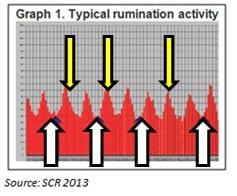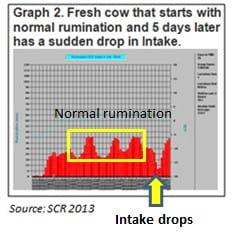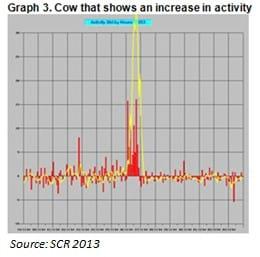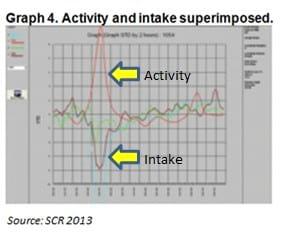Remote Health Monitoring Improves Dairy Cow’s Well-being
Published: June 10, 2014
By: Alvaro Garcia,Professor and Extension Dairy Specialist, South Dakota State University
Productivity and longevity of dairy cows are greatly influenced by proper nutrition programs. Human-animal interaction in larger dairies is limited, and ailments detection relies heavily on employees. Metabolic disorders and their complications such as hypocalcaemia, fatty liver, ketosis, displaced abomasum, acidosis, and laminitis may result from dietary inadequacies. Early veterinary attention increases treatment effectiveness and reduces overall costs. Troubleshooting dietary problems can be done by checking how many cows chew their cud, recording intake changes, manure consistency, and presence of undigested feed particles. Changes in short-term feeding behavior detected through computerized feeders have been associated with the onset of feeding disorders. Ketosis was associated with rapid decreases in daily intake, feeding period length and rate 3.6 days before clinical detection by employees (Gonzalez et al. 2008). In that same experiment cows with acute locomotion disorders had smaller daily decreases in intake, feeding period length, and daily increases in feeding rates during 7.7 days before actual clinical detection. Feeding disorders for example were detected in 80% of the cows at least 1 d before.

Producers, veterinarians and nutritionists have long relied on cud chewing to monitor cow health. One rule of thumb has been that among the cows lying down properly in stalls 50 to 60 percent should be chewing their cud. Assessing rumen activity and health in commercial dairies can nowadays be done through electronic monitoring of cud chewing. Graph 1 shows typical rumination activity in a healthy cow observed as daily peaks (yellow arrows; mid-night) and valleys (white arrows; mid-day) of rumination. As can be seen in the graph most rumination takes place during the night when the cows are resting.

Graph 2 depicts a fresh cow with starts to increase intake and thus rumination and all of a sudden rumination falls abruptly on day 5. This cow has to be looked closer for ketosis or even acidosis. Today’s electronic systems can also track the cow’s the cow’s activity simultaneously which is used to detect heats (Graph 3). Each cow is fitted with a reading tag that hangs from her neck. For the average dairy farm monitoring it the number of tags needed would probably be around one third of the total milking cows. The data stored in the tag is transmitted from through infrared communication each time a cow passes under a reading station (transceiver ID). This generates a report for every cow than can be read in the farm’s computer graphing rumination time, chewing rhythm and time between feed boluses. It also records the cow’s general activity both all animal movement and their intensity (walking, running, laying, standing up, head movements, etc.).

As cows in heat increase their activity this feature of the tags has been critical in substitution for visual heat detection. This feature has a great degree of accuracy when used in combination with the rumination graph (Graph 4) as a cow in heat will not only increase its activity but it will also reduce its intake. This has resulted in more than 95% heat detection according to producers that use the system. Even cystic ovaries can be detected which usually appear as consecutive intermittent activity peaks. In today’s dairy farms where trained help is difficult to come by this new technology can reduce labor, optimize time, and reduce veterinary costs.

This article was originally published in iGrow, a service of SDSU Extension, October 2013. Engormix.com thanks the authors for this huge contribution.
Related topics
Authors:
Join to be able to comment.
Once you join Engormix, you will be able to participate in all content and forums.
* Required information
Would you like to discuss another topic? Create a new post to engage with experts in the community.
Create a post13 de agosto de 2014
Thank for this interesting article.
It would be of my interest to ask whether you had the chance to look at the changes in the rumen pH as cows in heat. Graph 4 is great in terms of showing the increase in activity and drop in feed intake but would have been great if accompanied with data from rumen boluses on the pH.
We believe that in the UK, as a country that the cows do not commonly get into heat stress, managing the rumen pH by using rumen Boluses is the key factor to improve dairy cow productivity, reproductivity and general well being.
Regards,
Amer Masri






